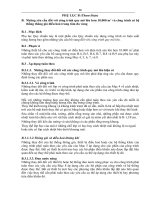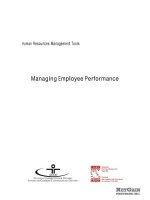09 managing underperformance
Bạn đang xem bản rút gọn của tài liệu. Xem và tải ngay bản đầy đủ của tài liệu tại đây (226.42 KB, 9 trang )
Working at best practice
Employers who work at best practice benefit from
motivated staff that are performing at their best.
These employers also understand that when issues
concerning underperformance are not addressed and
managed both appropriately and sensitively, it can
lead to unhealthy and unproductive outcomes that
may affect the entire workplace.
This Best Practice Guide helps explain what is meant
by underperformance and why this happens. It sets
out an easy to follow five-step plan to help employers
and employees address and manage issues about
underperformance.
There is also a checklist to assist best practice
employers.
This guide illustrates best practice when it comes to
managing underperformance. For specific information
regarding your minimum legal obligations, contact the
organisations listed under the ‘For more information’
section at the end of this guide.
Why work at best practice?
Establishing effective performance management
systems can have significant benefits for your
business, as it can lead to happier, more motivated
and better performing employees. Reviewing, refining
and implementing performance management
systems are ways of helping achieve these significant
benefits.
What is underperformance?
Underperformance or poor performance can be
exhibited in the following ways:
•
unsatisfactory work performance, that is, a
failure to perform the duties of the position or
to perform them to the standard required
•
non-compliance with workplace policies,
rules or procedures
•
unacceptable behaviour in the workplace
•
disruptive or negative behaviour that impacts
on co-workers.
Underperformance is not the same as misconduct.
Misconduct is very serious behaviour such as theft or
assault which may warrant instant dismissal. In cases
of misconduct employers should seek specific advice
about how to proceed before taking any action.
What are the reasons for
underperformance?
There are many reasons why an employee may
perform poorly. Some of the common reasons
include:
•
an employee doesn’t know what is expected
because goals and/or standards or
workplace policies and consequences are
not clear (or have not been set)
•
interpersonal differences
•
there is a mismatch between an employee’s
capabilities and the job they are required to
undertake, or the employee does not have
the knowledge or skills to do the job expected
of them
•
an employee does not know whether they
1
are doing a good job because there is no
counselling or feedback on their performance
•
lack of personal motivation, low morale in the
workplace and/or poor work environment
•
personal issues such as family stress,
physical and/or mental health problems or
problems with drugs or alcohol
•
cultural misunderstandings
•
workplace bullying.
Underperformance should be dealt with promptly and
appropriately by an employer, as employees are
often unaware they are not performing well and so are
unlikely to change their performance. Best practice
employers understand that issues that are not
addressed promptly also have the potential to
become more serious over time. This can have a
negative effect on the business as a whole as it can
affect the productivity and performance of the
entire workplace.
Helpful hints
Dealing with underperformance can be challenging
and confronting for employees and employers alike,
but it does need to be addressed. Managers need
clear procedures, organisational support and the
courage and willingness to manage the issue.
Provide training to managers on how to handle
underperformance issues. It may be helpful to include
role play workshops in the training material so that
managers can learn how to approach matters in real-
life scenarios. Well trained managers are better able
to identify and address issues of underperformance.
If performance problems arise, it is crucial that they
be resolved early. The longer that poor performance
is allowed to continue, the more difficult a satisfactory
resolution becomes, and the more the overall
credibility of the system may suffer.
Not every underperformance issue needs a structured
process. Explore other options for improving
performance, such as the use of continuous feedback.
Remember that for performance management to
be successful, the culture of the business should be
one which encourages ongoing feedback and
discussion about performance issues in open and
supportive environments.
How to manage underperformance
A clear system for managing underperformance is
good for both a business and its employees.
Best practice employers are aware that ineffective
performance management can dramatically reduce
the level of performance in a workplace. Employees
that perform well can lose motivation if they have to
carry the burden of poor performing colleagues. Also,
most employees who are not performing well would
like to improve.
Negative attitudes to performance management, or a
lack of credibility with the process, can be an
indication of an inadequate performance
management system. A consistent approach to
performance management provides opportunities to
address problems and generate effective solutions. A
successful performance management process is one
that supports the workplace culture and is accepted
and valued by employees.
2
Here is an easy to follow step by step guide to
managing underperformance.
Step 1 – Identify the problem
It is important to understand the key drivers of
performance or underperformance within the
workforce.
It is also important to correctly and specifically
identify the problem. Some common reasons for
underperformance are identified later in this guide.
Step 2 – Assess and analyse the problem
The employer should determine:
•
how serious the problem is
•
how long the problem has existed, and
•
how wide the gap is between what is
expected and what is being delivered.
Once the problem has been identified and assessed,
the employer should organise a meeting with the
employee to discuss the problem.
The employer should let the employee know the
purpose of the meeting in advance so they can
adequately prepare for the meeting.
The employee should be allowed to bring a support
person of their choice or a union representative to the
meeting. Employers working at best practice will
inform the employee that they can bring a support
person as a matter of process.
Step 3 – Meet with the employee to discuss
the problem
It is important that the meeting takes place in private
and in an environment that is comfortable and non-
threatening, away from distractions and interruptions.
The employer should begin by holding a discussion
with the employee to explain the problem in specific
terms. From this conversation, the employee should
be able to clearly understand:
•
what the problem is
•
why it is a problem
•
how it impacts on the workplace, and
•
why there is a concern.
The employer should discuss the outcomes they wish
to achieve from the meeting.
The meeting should be an open discussion and the
employee should have an opportunity to have their
point of view heard and duly considered. The
employer should listen to the explanation of why the
problem has occurred or to any other comments the
employee makes.
When having this type of meeting, it may be useful in
facilitating discussion to refer to recent positive things
that the employee has done to show them that you
also recognise and appreciate their strengths.
Key points for employers to remember when holding
the meeting are to:
•
talk about the issue and not the person
•
explore the reasons why there is an issue
•
clarify details
•
stay relaxed and encouraging, and
•
summarise to check your understanding
of the situation.
And, when discussing shortfalls in any area, it is
important to check that the employee:
3
•
is aware that it is a task that is required of
them
•
has been shown what is required, and
•
understands the gap between what is
happening and what is required.
Step 4 – Jointly devise a solution
Where possible, it is important that a solution is jointly
devised with the employee. An employee who has
contributed to the solution will be more likely to
accept and act on it.
When working out a solution, the employer should:
•
explore ideas by asking open questions
•
emphasise common ground
•
keep the discussion on track
•
focus on positive possibilities, and
•
offer assistance, such as further training,
mentoring, flexible work practices or
redefining roles and expectations.
A clear plan of action should be developed with the
employee to implement the solution. This can be in
the form of a performance agreement or action plan.
A performance agreement or action plan can:
•
reflect an understanding of performance
expectations and what is to be achieved over
the specified time period (performance
improvement milestones)
•
clarify roles and responsibilities of the
employee
•
include strategies for training and career
development
•
include timeframes for improvement (these
may vary depending on the issue and needs
of the business, however it is important to
give an employee adequate time to improve
their performance)
•
reinforce the value and worth of the role
being performed.
A date should be set for another meeting with the
employee to review progress and discuss the
employee’s performance against the agreed action
plan.
The employer should keep a written record of all
discussions relating to underperformance in case
further action is required. Generally, it may also be
used as evidence if legal action is taken about the
matter.
Helpful hint
When devising a solution, make sure it is clear and
easy to follow and does not rely on ‘performance-
management speak’. Use everyday language to
avoid alienating both managers and employees. For
example, if terms such as ‘KPIs’ (Key Performance
Indicators) aren’t part of everyday language, don’t
use them in performance discussions and
agreements.
Step 5 – Monitor performance
The employer should monitor the employee’s
performance and continue to provide feedback and
encouragement.
4
A meeting to review and discuss the employee’s
performance should be held even if there is no longer
an issue. This enables both parties to acknowledge
that the issue has been resolved. The employer
should provide both positive and negative feedback
to the employee and should work with the employee
to ensure that performance improvements are
sustained.
More serious action may need to be taken if the
employee’s performance does not improve including
further counselling, issuing formal warnings and
ultimately if the issue cannot be resolved, termination
of employment.
Termination of employment
If an employee’s performance does not improve to an
acceptable standard, termination of their employment
may be an option.
Employers cannot dismiss their employees in
circumstances that are “harsh, unjust or
unreasonable”. What is harsh, unjust or
unreasonable will depend on the circumstances of
each case. However, it is important to be fair to
employees particularly when it comes to termination
of employment. They should be given reasons for
dismissal and an opportunity to respond to those
reasons.
Importantly, employers with fewer than 15 employees
(based on a simple headcount) will be covered by
special dismissal arrangements which are different to
those that apply to larger businesses. The special
arrangements that apply to employers with fewer
than 15 employees are:
•
employees will need to have worked for the
business for 12 months in order to be eligible
to make a claim for unfair dismissal, and
•
if a small business employer strictly follows
the Small Business Fair Dismissal Code and
the dismissal of their employee is not harsh,
unjust or unreasonable, then the dismissal
will be deemed to be fair. It is best practice to
follow the code and fill out the Small
Business Fair Dismissal Code Checklist at
the time an employee is dismissed and you
should keep the Checklist with your records
as it will assist you if an employee makes an
unfair dismissal claim.
A link to the code and Checklist is available at
the ‘For more information’ section at the end
of this guide.
You should also ensure that you provide the
employee with their entitlements such as their notice
of termination and any annual leave that they have
accrued. For more information on the entitlements
you may owe after termination, visit
www.fairwork.gov.au or contact the Fair Work Infoline
on 13 13 94.
Common performance issues
The following table (overleaf) provides a summary of
common issues faced by employers and employees
when managing performance and identifies key ways
to improve performance management systems in the
workplace.
5
6
7
Checklist for employers when managing
underperformance
•
Ensure employees clearly understand what
is expected of them
•
Clearly identify and then assess the problem
•
Organise a meeting with the employee to
discuss the problem
•
Give the employee time to prepare for the
meeting
•
Allow the employee to bring a support person
to the meeting
•
Conduct the meeting in a private, non-
threatening, comfortable and quiet location
•
Define and explain your concerns to the
employee in specific terms
•
Give the employee a genuine opportunity
to respond before considering your actions
•
Where an employee’s performance is
suffering due to the employee’s personal
circumstances, refer the employee to
professional help or counselling
•
Clearly outline the improvement required and
the consequences of continued poor
performance
•
Devise a solution with the employee
to improve performance
•
Develop an action plan which includes
performance improvement milestones and
time frames for further review
•
Schedule another meeting to review the
employee's performance against the agreed
action plan
•
Document all discussions, including actions
to be taken
•
Monitor the employee's performance and
continue to provide feedback
•
Follow any steps set out in an applicable
industrial instrument (such as a modern
award or enterprise agreement), the
employer’s policies and procedures and the
employee’s employment contract concerning
performance management
•
For small business, know and comply with
the Small Business Fair Dismissal Code
(available through the Fair Work website –
see overleaf).
For more information
Fair Work Ombudsman
13 13 94
www.fairwork.gov.au
Fair Work Australia
1300 799 675
www.fwa.gov.au
8
To download the Small Business
Fair Dismissal Code & Checklist
/>business-fair-dismissal-code
To calculate whether your business
is a small business
/>n_small_business.pdf
Disclaimer
Fair Work Ombudsman is committed to providing
useful, reliable information to help you understand
your rights and obligations under workplace laws. It is
your responsibility to comply with workplace laws that
apply to you. The information contained in this
publication is: general in nature and may not deal
with all aspects of the law that are relevant to your
specific situation; and not legal advice.
Therefore, you may wish to seek independent
professional advice to ensure all the factors relevant
to your circumstances have been properly
considered. Produced December 2011. ©
Commonwealth of Australia 2011.
9









